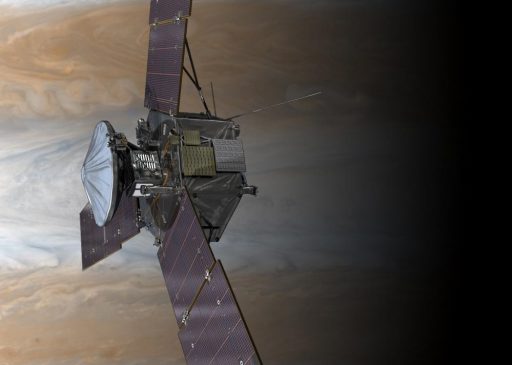
NASA’s Juno spacecraft successfully sailed into orbit around Jupiter Monday night after a five-year journey through the Solar System, becoming only the second craft to enter orbit around the gas giant and coming closer than any previous mission to deliver unprecedented data from a largely unexplored world that lies beneath Jupiter’s clouds.
It had been a tense day at NASA’s Jet Propulsion Laboratory and spacecraft builder Lockheed Martin where engineers were closely watching over the Juno spacecraft as it entered a high-speed dance with Jupiter which had begun pulling the spacecraft in with its intense gravitational field in May.
Out in the dark outer solar system, 868 million Kilometers from Earth, Juno fired up its main engine at 2:30 UTC on Tuesday. Signals needed 48.3 minutes to travel to Earth where they were received by NASA’s large 70-meter Deep Space Network dishes. Hitting the brakes, Juno fired its engine for 35 minutes and two seconds to slow down by 542 meters per second in order to be captured in an elongated orbit around the gas giant.
>>Recap of Juno’s Orbital Insertion
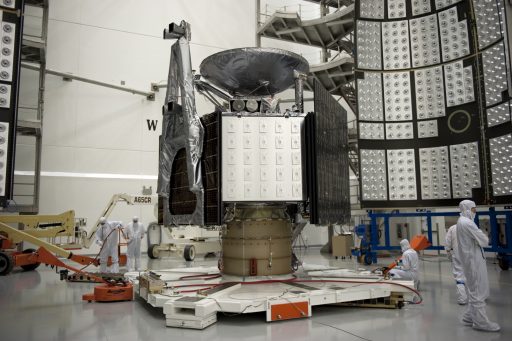
Now at its destination after traveling 2.8 billion Kilometers through the solar system, Juno is set for a pair of capture orbits, each lasting 53.5 days, before the spacecraft will lower itself into a 14-day mapping orbit to begin its science phase expected to last 16 months.
Juno carries nine scientific instruments comprising 29 sensors to probe Jupiter’s atmosphere beneath its cloud tops, search for a possible solid core, look for previously unknown moons, examine Jupiter’s magnetic field and plasma environment, and obtain the highest resolution pictures of Jupiter when passing over Jupiter’s cloud tops at an altitude of less than 5,000 Kilometers – ten times closer than any previous spacecraft came to the planet.
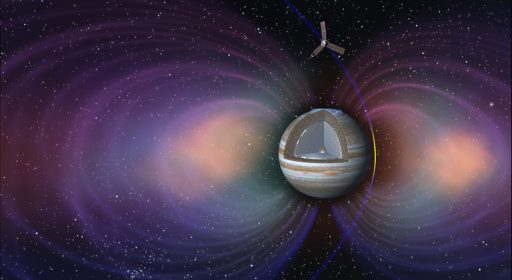
The mission’s principal objective is to understand the origin and evolution of Jupiter and to explore the phenomena driving the planet’s bright auroral display and intense magnetic field that would match the size of the Moon in the night sky if it was visible to the human eye.
Underneath its dense cloud cover, Jupiter harbors secrets about the fundamentals of solar system formation, pertaining to the processes and conditions that led to the creation of planetary bodies – also around other stars.
A big unknown is Jupiter’s formation – whether a planetary core was formed first and captured a large quantity of gas through gravitation or whether an unstable region collapsed within the cloud of gas and dust present in the infancy of the solar system.
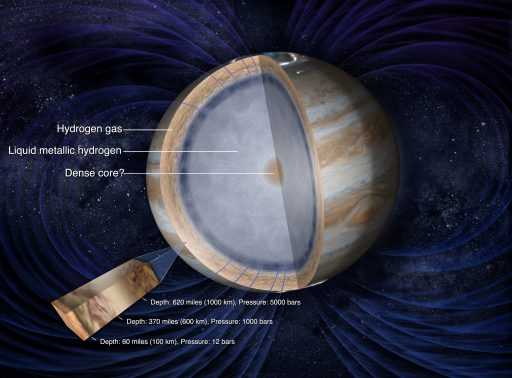
One of the biggest questions surrounding Jupiter is whether it has a solid core or is indeed a massive gaseous world. No study of Jupiter’s core is possible from afar since its dense clouds preclude any remote observation.
Even Juno’s sounding and imaging instruments will not be able to penetrate deep enough to spot a solid core. Instead, scientists will use the entire spacecraft as their instrument, precisely tracking its orbit using a two-way ranging method to reveal even the tiniest changes of Juno’s orbital path caused by gravitational acceleration/deceleration.
However, the Gravity Science experiment will be in for the long haul as a number of readings from at least half of Juno’s science phase have to be accumulated to allow scientists to conduct an assessment of Jupiter’s deep interior. The matter is further complicated by Jupiter’s large moons that are constantly in motion and also exert a small gravitational pull on the spacecraft which needs to be factored into data analysis.
One of Jupiter’s features that can be observed by telescopes is its upper atmosphere with the characteristic orange-and-white belts, zonal bands running parallel to the equator bounded by powerful atmospheric flows. The origins of the bonded structure are not well understood beyond theoretical models and what lies beyond is also a mystery for Juno to solve.
>>Detailed technical Overview of all nine Juno Instruments
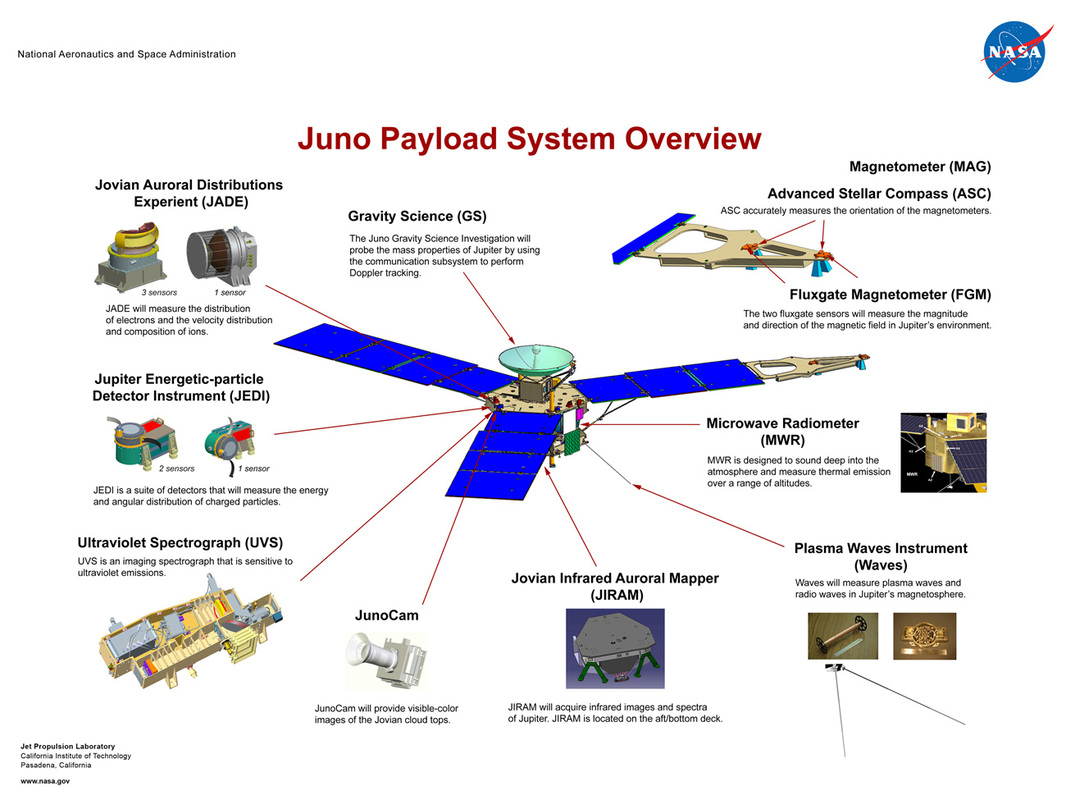
The Galileo probe, entering Jupiter orbit in 1995, dispatched a 340-Kilogram atmospheric probe that successfully returned data up to a depth of 132 Kilometers below Jupiter’s 1bar pressure level. Galileo and telescopic observations provided the composition of Jupiter’s atmosphere, though the dynamics ongoing beyond the cloud tops remain to be studied from close by.
Juno’s Microwave Radiometer is the mission’s primary instrument for atmospheric studies, measuring ambient microwaves emitted by Jupiter at six different frequencies to obtain vertical profiles of the atmosphere up to a depth of around 550 Kilometers below the cloud tops. The instrument will be able to deliver information on the structure, movement and chemical composition of the Jovian atmosphere, looking at dynamic processes responsible for a continuous change in Jupiter’s appearance.
Water is one focus of the Juno mission as a possible water interior of Jupiter would provide valuable information on Jupiter’s formation in the early stages of the solar system. Ammonia, known to be present in Jupiter’s clouds, will also be studied via radiometric measurements and is of particular interest with recent discoveries of areas of high and low ammonia concentrations around Jupiter’s equator. Some of these ammonia hot spots dwarf even Jupiter’s Great Red Spot in size and raise a number of questions to be answered by Juno and its atmospheric instrument.
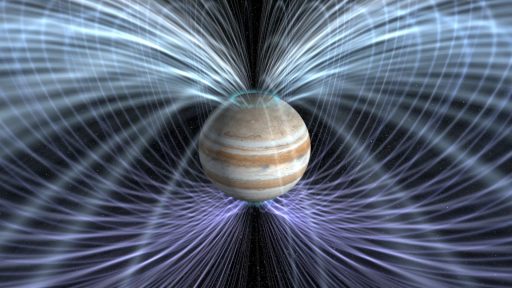
Riding on a dedicated boom mounted to one of Juno’s three solar arrays is the mission’s Magnetometer instrument, installed far from the body of the spacecraft to avoid interference by Juno’s own magnetic field. The instrument will create the first global map of Jupiter’s intense magnetic field, created by a dynamo process involving Hydrogen in the high-pressure atmosphere.
Jupiter presents the biggest magnetic field of any planet in the solar system and, unlike Earth, does not hide its dynamo beneath crustal rock. This will permit Juno to uncover the source of Jupiter’s dynamo, hypothesized to be either electrically-conducting hydrogen gas in the upper atmosphere or hydrogen in its metallic state in the higher pressures of the lower atmosphere.
The magnetic field at Jupiter is about 20 times stronger than Earth’s field, but the study of dynamo mechanisms will also yield insight into the processes hidden by Earth’s magnetic crust.
Juno’s Waves instrument measures radio and plasma waves in the Jovian environment with a pair of V-shaped antennas to deliver data needed to tie processes in the magnetosphere to atmospheric phenomena.
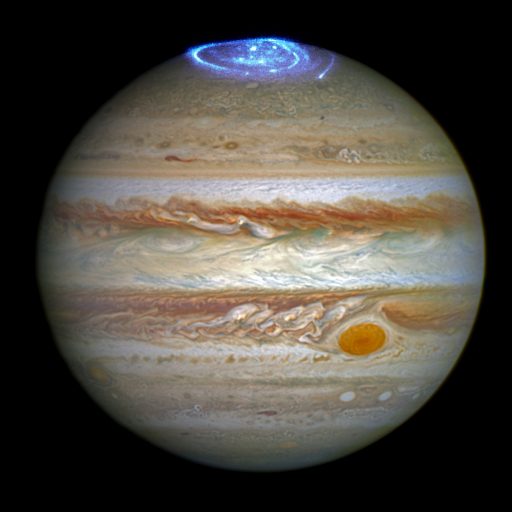
A pair of Energetic Particle Instruments, called JEDI and JADE, have multiple sensor heads on the Juno spacecraft to measure the energy spectra, species and distribution of charged particles including electrons and heavier ions of hydrogen, helium, oxygen and sulfur. The two instruments cover the complete energy range from 0 to 1 Mega-Electronvolt to study the interaction of charged particles with Jupiter’s intense magnetic field.
JADE and JEDI will be able to pinpoint the source of the particles, coming either from the sun or originating from volcanic activity on the Jovian moons.
Jupiter’s magnetic field creates an inflow of particles to generate the most powerful auroras in the solar system. Their underlying mechanism is very much up to debate and Juno is hoped to deliver close-up data that will reveal what’s behind the persistent aurora seen on Jupiter which. JEDI and JADE will be responsible for tracking the particles that create the auroras while spectrometric instruments are responsible for direct observations of the northern and southern lights.
UVIS, the Ultraviolet Spectrograph, is sensitive for wavelengths in which Jupiter’s auroras are brightest. The instrument is tasked with characterizing the sources of Jupiter’s powerful auroras which are not well understood and scientist will try to tie the particle inflow measured by JEDI and JADE to auroral displays in the atmosphere.
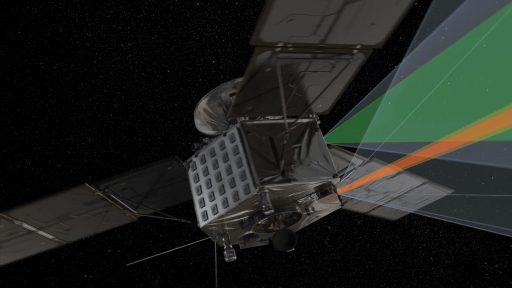
Watching the aurora from the opposite side of the spectrum will be the JIRAM instrument, capturing infrared views of the auroral display and probing its mechanism down to a depth of 70 Kilometers below the cloud tops. It is also capable of probing the atmosphere’s composition with respect to key gases such as water, ammonia and phosphine.
Monitoring heat radiated from Jupiter will enable scientists to look at cloud convection and energy transfer below the cloud tops.
Finally, JunoCam – classed as an educational payload – will collect the highest resolution photos of Jupiter to date, reaching a resolution of three Kilometers during the lowest passes of the mission. JunoCam delivers 1600 x 1200 RGB images and hosts a methane filter to be able to study methane in the Jovian atmosphere to contribute to the overall science of the mission.
Juno is the first mission flying straight over Jupiter’s polar regions, promising some unique and never before seen views to be beamed back to Earth.
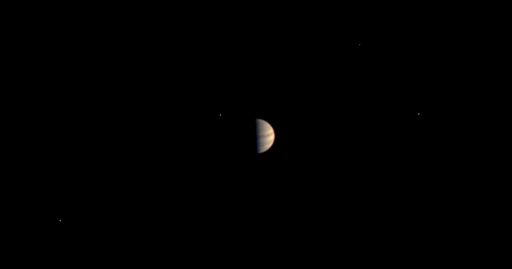
JunoCam and Juno’s star trackers will also be employed to look for new moons, several of which are expected to be found over the course of the mission.
Juno’s primary mission is planned to end on February 20, 2018 – a date that previously seemed to be set in stone as an extended mission was ruled out for planetary protection reasons. Newer information shared by the mission team indicates that a mission extension is at least on the table, pending Juno’s performance in Jupiter’s extreme radiation environment.